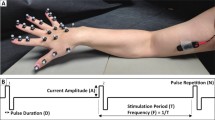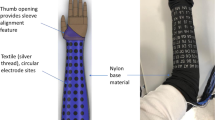Abstract
Neuroprosthestic systems can be used to restore hand grasp and wrist control in individuals with C5/C6 spinal cord injury. A computer-based system was developed for the implementation, tuning and clinical assessment of neuroprosthetic controllers, using off-the-shelf hardware and software. The computer system turned a Pentium III PC running Windows NT into a non-dedicated, real-time system for the control of neuroprostheses. Software execution (written using the high-level programming languages LabVIEW and MATLAB) was divided into two phases: training and real-time control. During the training phase, the computer system collected input/output data by stimulating the muscles and measuring the muscle outputs in real-time, analysed the recorded data, generated a set of training data and trained an artificial neural network (ANN)-based controller. During real-time control, the computer system stimulated the muscles using stimulus pulsewidths predicted by the ANN controller in response to a sampled input from an external command source, to provide independent control of hand grasp and wrist posture. System timing was stable, reliable and capable of providing muscle stimulation at frequencies up to 24 Hz. To demonstrate the application of the test-bed, an ANN-based controller was implemented with three inputs and two independent channels of stimulation. The ANN controller's ability to control hand grasp and wrist angle independently was assessed by quantitative comparison of the outputs of the stimulated muscles with a set of desired grasp or wrist postures determined by the command signal. Controller performance results were mixed, but the platform provided the tools to implement and assess future controller designs.
Similar content being viewed by others
References
Abbas, J. J., andChizeck, H. J. (1995): ‘Neural network control of functional neuromuscular stimulation systems: computer simulation studies’,IEEE Trans. Biomed. Eng.,42, pp. 1117–1127
Abbas, J. J. (1997): ‘Neural networks for control of posture and locomotion’,Proc. American Control Conference, Albuquerque, New Mexico, pp. 3289–3293
Adamczyk, M., andCrago, P. E. (1997): ‘Integrated hand/wrist control in a neuroprosthesis for individuals with tetraplegia’,Proc. 19th Int. Conf. IEEE/EMBS, Chicago, IL,5, pp. 1924–1927
Adamczyk, M., andCrago, P. E. (2000): ‘Simulated feed-forward neural network coordination of hand grasp and wrist angle in a neuroprosthesis,IEEE Trans. Rehabil. Eng. (see alsoIEEE Trans. Neural Syst. Rehab.),8, pp. 297–304
Buckett, J. R. (1988): ‘A flexible portable system for neuromuscular stimulation in the paralyzed upper extremity’,IEEE Trans. Biomed. Eng.,35, pp. 897–904
Davoodi, R., andLoeb, G. E. (2002): ‘A software tool for faster development of complex models of musculoskeletal systems and sensorimotor controllers in Simulink’,J. App. Biomech.,18, pp. 357–365
Davoodi, R., Brown, I. E., andLoeb, G. E. (2003): ‘Advanced modeling environment for developing and testing FES control systems’,Med. Eng. Phys.,25, pp. 3–9
Demuth, H., andBeale, M. (1992): ‘Neural network toolbox for use with MATLAB: user's guide’. (MathWorks, Inc. Natick, MA, 1992), p. 138
Hoshimiya, N., Naito, A., Yajima, M., andHada, Y. (1989): ‘A multichannel FES system for the restoration of motor functions in high spinal cord injury patients: a respiration-controlled system for multijoint upper extremity’,IEEE Trans. Biomed. Eng.,36, pp. 754–760
Keith, M. W., andLacey, S. H. (1991): ‘Surgical rehabilitation of the tetraplegic upper extremity’,J. Neuro Rehab.,5, pp. 75–87
Khanna, T. (1990): ‘Foundations of neural networks’ (Addison-Wesley, Reading, Massachusetts, 1990)
Kilgore, K. L., Peckham, P. H., Thrope, G. B., Keith, M. W., andGallaher-Stone, K. A. (1989): ‘Synthesis of hand grasp using functional neuromuscular stimulation’,IEEE Trans. Biomed. Eng.,36, pp. 761–770
Machino, T., Murakami, H., Watanabe, T., Ohba, S., Futami, R., Hoshimiya, N., andHanda, Y. (1995): ‘FES control of wrist joint angles based on the interpolation of stimulus-angle characteristics’.Proc. 2nd Int. FES Symposium, Sendai, Japan
Memberg, W. D., andCrago, P. E. (1995): ‘A grasp force and position sensor for the quantitative evaluation of neuroprosthetic hand grasp systems’,IEEE Trans. Rehabil. Eng (see alsoIEEE Trans. Neural Syst. Rehabil. Eng.),3, pp. 175–181
Popovic, D. B. (1992): ‘Functional electrical stimulation for lower extremities’, inStein, R. B., Peckham, P. H., andPopovic, D. B. (Eds): ‘Neural prostheses: replacing motor function after disease or disability’ (Oxford University Press, New York, 1992)
Popovic, D. B., Stein, R. B., Oguztoreli, N., Lebiedowska, M., andJonic, S. (1999): ‘Optimal control of walking with functional electrical stimulation: a computer simulation study’,IEEE Trans. Rehabil. Eng.,7, pp. 69–79
Smith, B., Tang, Z., Johnson, M. W., Pourmehdi, S., Gazdik, M. M., Buckett, J. R., andPeckham, P. H. (1998): ‘An externally powered, multichannel implantable stimulator-telemeter for control of paralyzed muscle’,IEEE Trans. Biomed. Eng.,45, pp. 463–475
Smith, B., Peckham, P. H., Keith, M. W., andRoscoe, D. D. (1987): ‘An externally powered, multichannel, implantable stimulator for versatile control of paralyzed muscle’,IEEE Trans. Biomed. Eng.,34, pp. 499–508.
Tong, K. Y., Mak, A. F. T., andIp, W. Y. (2003): ‘Command control for function electrical stimulation hand grasp systems using miniature accelerometers and gyroscopes’,Med. Biol. Eng. Comput.,41, pp. 710–717
Author information
Authors and Affiliations
Corresponding author
Rights and permissions
About this article
Cite this article
Luján, J.L., Crago, P.E. Computer-based test-bed for clinical assessment of hand/wrist feed-forward neuroprosthetic controllers using artificial neural networks. Med. Biol. Eng. Comput. 42, 754–761 (2004). https://doi.org/10.1007/BF02345208
Received:
Accepted:
Issue Date:
DOI: https://doi.org/10.1007/BF02345208




